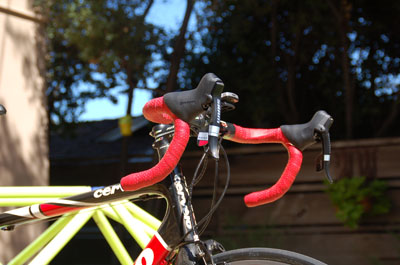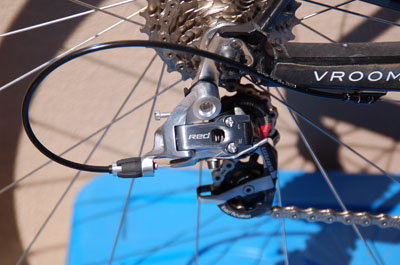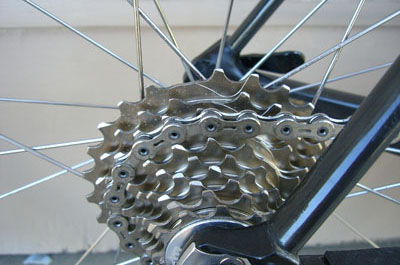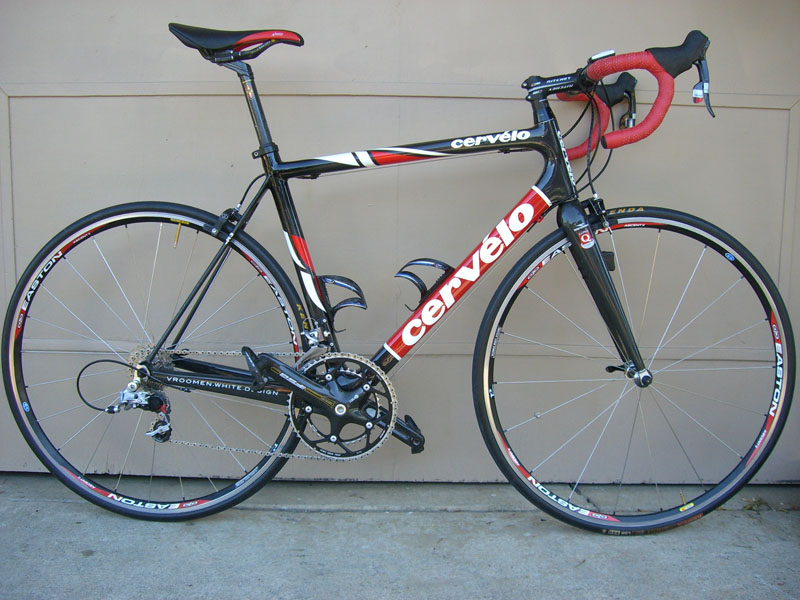This is a review of the SRAM Red 5-piece upgrade. I've been sticking with Shimano 9-speed Dura Ace because I have 4 road bikes that I'm always switching components on. Plus, I haven't really seen a compelling reason to switch my Dura Ace Octalink BB (175 grams) and FSA Superlight Cranks (522 grams) for the new-tech outboard bearing cranks; they aren't significantly lighter and are a lot more expensive. However, I recently bought a new used Cervelo R3 and the weight-weenie bug struck hard. Plus, the 11-26 SRAM cogset seems like a great upgrade that lends a huge range of flexibility. Shimano offers only 11-23 or 12-25. And the Red component group is rumored to be much lighter. It was time to upgrade to 10 speed. Plus I pooled my 42nd birthday funds to afford the upgrade.

Cost/Benefit
Below is pricing and weights from the Excel Sports web site (as of 9/29/08). Last year's Dura Ace and Campy Record 10-speed currently have steep discounts while the new Dura Ace and Campy 11-speed have big premiums as they are being introduced. SRAM Red is in between; more expensive than the 2008 models but less expensive than the 2009 models. But lighter than all. Kudos to SRAM for forcing the competition to go back to the drawing board. This being said, the original Dura Ace 9 Speed has certainly stood the test of time and is a remarkable value for price and weight.
Weights
The SRAM shifters came with the shift cables installed. I didn't want to remove them so weighed them together, they came in at 323 grams, 53 more than the
claimed naked weight. But still far less than the 485 for D/A 9 Speed. Campy and SRAM shifters are a lot lighter than D/A, regardless of the model. Also, the cassette, chain, and rear derailleur were largely on track though the Front Derailleur was way off. I chose to compare "claimed" weight according to Excel Sports to provide the most consistent baseline.
Regarding costs, it is ABSURD to think that shifters are now over $500. And the new Dura Ace at SEVEN HUNDRED DOLLARS should be considered criminal. $300+ for a rear derailleur is also getting out of hand. As 2008 draws to a close, deals can be found on last year's models so keep an eye out.
Component Highlights - Shifters
In a few years, I think the cycling community will look at Shimano shifters
that have the derailleur cables coming out at 90 angles as totally primitive. SRAM and Campy offer cable routing that follows the taper of the bar. SRAM even offers the ability to route the derailleur cables either inboard or outboard. How smart is this? Having both cables route on the inside provides a seamless transition along the handlebar-awesome. Ironically, I did initially miss the "safety blanket" feel of the cable jutting out as a hand hold. But I'll get over this. As a side note, I believe Campy has offered multiple cable positions for some time.
Another cool feature is the SRAM Red shifters/brake levers also offer adjustable reach. But I chose to leave the reach in the default position.
How do they work? The shifters are very fast and have a nice, positive and substantial feel. The front derailleur has a bit of a long throw to get into the big ring, but it is not objectionable. Shifting the rear down from the 26 to the 23 was a bit tricky; it will take some time to master the small step down versus clanking all the way to the 21. But overall, not a traumatic change from Shimano. And as I get used to it, I am sure it will become second nature. 
Component Highlights - Derailleurs
The derailleur set up was just plain finicky. SRAM provides terrible documentation, and the group I got from Colorado Cyclist had almost no packaging. I resorted to the web site's downloadable PDF for "dealers" . This proved to be helpful but not perfect.
Rear derailleur: What's cool-the angle between the cable exit and shifter comes out at a sharp angle which locks the cable; it's easier to adjust cable tension than with Shimano. But it was very difficult to set the b-tension screw
correctly. Unfortunately, perhaps because of the wide gear range provided by the 11-26, it wasn't possible to dial out chain rub in the 11 and 12 tooth cog while riding in the front small ring. There is significant chain rub in either gear. Additionally, the manual calls for maintenance/relube of the ceramic bearings every 100 miles. I have to say that that is a bit of a pain in the butt.
Front derailleur. The front derailleur provides trimming in the big ring; if you are mid-ring in back, you can semi-shift the FD to drop down a bit. This gives more flexibility in the middle gears and even allows cross-chaining without rub. This being said, in the 53x11, the chain would rub and slip. Adding more travel
to the big ring simply meant over-shifts with the chain dropping off. I think I have to visit my LBS for fine tuning of the front and rear.


Component Highlights - Cogset and Chain
The cogset really steals the show. It is machined from one piece of steel and is hollowed out inside! This is pretty ingenious. More amazing, I love the 11-26 combo and wonder why no one else thought of this. The cogset has a third piece-a sleeve that goes over the cassette body. This proved to be problematic as the sleeve wouldn't fit over the cassette body. I exercised restraint (ie, didn't hammer it in to place) and had my LBS, Calmar Cycles, do the final install. This involved using a Dremel tool to file down the detents in the freewheel. Please note, if you are an SRAM Red owner and don't have the sleeve--get one! The customer care rep at Easton (I have Easton Ascent II's) strongly suggested using it and warned of death/serious injury. SRAM also says it keeps water out. The cogs also feature flat spots that are supposed to make the chain pickup faster. Not sure if this works, but it seemed very quick to me. The finish is also a nice and bright. The chain, 1090-r, features hollowed side plates and weighs in at very light 260 grams. Not bad. The chain/cogset combo is a bit noisier than Shimano with a louder, more mechanical "whirring" sound.


The finished product!
All in all, the SRAM upgrade yielded wider gearing (11-26), 10-speed Shimano capability (you can use a Shimano cogset), as well as 8 ounces of weight savings. I also put on lighter cranks (-53 grams) and skewers (-23 grams) netting a loss of 270 grams/ 9.6 ounces.
Here's the finished product at 14pounds, 7 oz or 6560 grams.


